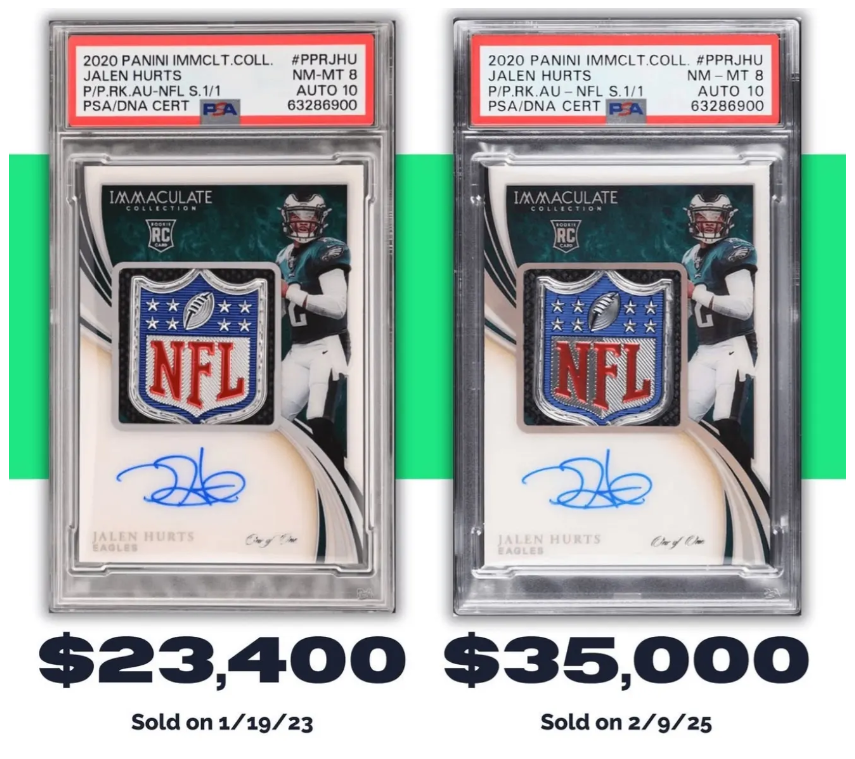In the ever-ebullient world of sports memorabilia, where the value of a piece of cardboard can outstrip even some classic cars, aficionados and investors are left with but one pressing question: when is the best time to buy or sell? And who better to personify this phenomenon than Jalen Hurts, whose recent escapades on the field have left even the most stoic collectors breathless and, perhaps, a little puzzled.
Flash back to January 19, 2023—a simpler time. Back then, a Jalen Hurts rookie card from the illustrious 2020 Panini Immaculate Collection, specifically the 1/1 NFL Shield Auto graded PSA 8/Auto 10, found its new home for a mere $23,400. A princely sum, no doubt, but little did anyone know that this cardboard warrior’s fortunes were set to ascend in spectacular fashion.
Fast forward to February 9, 2025, and the bright lights of Super Bowl LIX have faded, but what hasn’t dimmed is Hurts’ ability to command attention, both on the field and on the auction block. His glorious performance not only earned him a spot in the hearts of fans but also saw his card resell for a stupendous $35,000, a stat line any investor would pine for. It’s one of those rare moments where sports, speculation, and investment form a trifecta of triumphs.
Yet, amidst the applause and celebration, lies a serious question: is this princely price the climax of Hurts’ card market, or merely a prelude to an epic saga? It’s the kind of pondering that keeps sports enthusiasts and card collectors alike debating far into the night, over whatever beverage may suit the mood.
To truly decipher this conundrum, one must delve into the enchanted forest of sports card economics. Sure, any championship-winning quarterback is apt to see a spike in stock, tangled neatly with ribbons of excitement and speculation. When you pin an MVP badge on that jacket, well, the market practically swoons. Jalen Hurts, fresh off a championship victory, now basks in the Fort Knox-like shine that signals more than just a flash-in-the-pan moment; this is the stuff that legends, and more importantly, legend marketers thrive on.
The value increment, a leap of nearly 50%, might scream ‘bubble’ to the uninitiated, but consider the factors at play. Super Bowl victories have traditionally buoyed quarterback markets; rings on fingers lead to zeros in bank accounts. Hurts’ MVP status is not just bling for the trophy case—it’s a gilt-edged invitation into NFL royalty, guaranteeing a place in the memorabilia zeitgeist that audiences and investors gobble up with palpable hunger.
Furthermore, irrespective of smaller market tremors, the arena of high-end sports cards remains unfazed, a bastion of solid investment potential—the sort of modern treasure that enthusiasts hope will age as well as a fine Bordeaux. And so, with the sport’s newest darling firmly in the mix, enthusiasts are faced with an age-old decision: is it time to purchase, pause, or partake in a sale?
This particular piece of cardboard paints a story deeper than just a dip or peak in value—it narrates a tale of potential. If one believes Hurts has more jewelry in his future, especially those treasured rings, now’s the moment to secure a piece of the dream. Should someone instead be inclined to seize today’s profits, there’s no shame in striking while the iron (and the market) is hot. Others, of course, will play the long game, holding steadfast to see if Jalen Hurts’ career will burgeon into the stuff of empires.
The post-season, traditionally a period of somnolence in the card market, becomes the calm eye before the storm. As any seasoned dealer or casual fan will know, prognostication of such meteoric markets is akin to predicting the weather—the true test arrives not in the frenzy of sales but in subtle market shifts during this lull.
So, as Jalen Hurts holds his MVP trophy aloft, under the glare of less tangible lights, his market too seems destined to twinkle. Whether this $35,000 figure represents the dawn or the dusk of his market remains speculative—a puzzle for the pundits to ponder, and for history to one day reveal. What is certain, however, is that this is only one chapter in what promises to be a riveting page-turner of value, legacy, and iconography.
